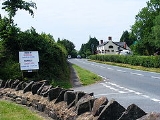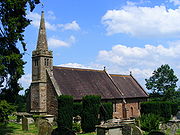
Peterstow
Encyclopedia
Peterstow is a village and Civil parish in Herefordshire
, England
situated about 2 miles (3 km) west of Ross-on-Wye
on the A49
.
include the Parish Church, a former Wesleyan Methodist
Chapel, and The Common, with a war memorial in the form of a stone cross bearing the village name. There is also a pub, the Yew Tree, and a village stores and Post office. The village school closed in 1969, and is now a private dwelling.
The village bakery is a successful business which has a shop in Ross-on-Wye.
In 1874, a Mr. Thomas Blake gave land for the Wesleyan Methodists to build a chapel. In the simpler architectural style typical of the Primitive Methodists, this was used by the Wesleyans for 50 years. The Chapel was bought by the Parish Church in 1924, and used as a church hall until a few years ago. It was sold because it is not possible to install modern facilities including water supply and drainage. It is now in private ownership.
Possibly the earliest record of habitation in the area relates to iron ore smelting in Roman, and possibly medieval times. Artifacts relating to this are on display in the Heritage Centre at Ross.
In 1100, Henry I
set up 3 royal manors in Herefordshire, including the manor of Wilton, which included Peterstow.
 St Peter's Church is in the Ross and Archenfield Deanery of the Diocese of Hereford
St Peter's Church is in the Ross and Archenfield Deanery of the Diocese of Hereford
.
The earliest known building was Anglo-Saxon, built on the site of an existing burial ground. A reference in the Book of Llandaff
says that Herwald, Bishop of Llandaff, consecrated a church at Llanbedr in 1066. A 12th century Norman building replaced this, using some of the enormous foundation stones. This was rebuilt in 1330. A font and bell tower were added in the 15th century, and a panelled pulpit in the 17th.
The present appearance of the building is due to the "great restoration" in the 1860s, under the rector, Dr John Jebb
with Sir George Gilbert Scott as architect. The re-opening was on 2 July 1866.
In 2009 the nave
was "re-ordered", the pews being removed and a modern wooden floor and chairs being installed. The west end was partitioned off to provide for a kitchem, and a toilet to disabled access standards. Other equipment includes a new amplification system with audio induction loop. The nave is available as a village hall when not required for Church services. The chancel has not been altered during this work (other than redecoration), and preserves the character of a place of Christian worship.
long distance footpath
passes through the village.
Herefordshire
Herefordshire is a historic and ceremonial county in the West Midlands region of England. For Eurostat purposes it is a NUTS 3 region and is one of three counties that comprise the "Herefordshire, Worcestershire and Gloucestershire" NUTS 2 region. It also forms a unitary district known as the...
, England
England
England is a country that is part of the United Kingdom. It shares land borders with Scotland to the north and Wales to the west; the Irish Sea is to the north west, the Celtic Sea to the south west, with the North Sea to the east and the English Channel to the south separating it from continental...
situated about 2 miles (3 km) west of Ross-on-Wye
Ross-on-Wye
Ross-on-Wye is a small market town with a population of 10,089 in southeastern Herefordshire, England, located on the River Wye, and on the northern edge of the Forest of Dean.-History:...
on the A49
A49 road
The A49 is a major road in western England, which traverses the Welsh Marches region. It runs north from Ross-on-Wye in Herefordshire via Hereford, Leominster, Ludlow, Shrewsbury and Whitchurch, then continues through central Cheshire to Warrington and Wigan before terminating at its junction with...
.
General description of the village
The general features of the villageVillage
A village is a clustered human settlement or community, larger than a hamlet with the population ranging from a few hundred to a few thousand , Though often located in rural areas, the term urban village is also applied to certain urban neighbourhoods, such as the West Village in Manhattan, New...
include the Parish Church, a former Wesleyan Methodist
Methodist Church of Great Britain
The Methodist Church of Great Britain is the largest Wesleyan Methodist body in the United Kingdom, with congregations across Great Britain . It is the United Kingdom's fourth largest Christian denomination, with around 300,000 members and 6,000 churches...
Chapel, and The Common, with a war memorial in the form of a stone cross bearing the village name. There is also a pub, the Yew Tree, and a village stores and Post office. The village school closed in 1969, and is now a private dwelling.
The village bakery is a successful business which has a shop in Ross-on-Wye.
In 1874, a Mr. Thomas Blake gave land for the Wesleyan Methodists to build a chapel. In the simpler architectural style typical of the Primitive Methodists, this was used by the Wesleyans for 50 years. The Chapel was bought by the Parish Church in 1924, and used as a church hall until a few years ago. It was sold because it is not possible to install modern facilities including water supply and drainage. It is now in private ownership.
History
The name of the village has changed several times during the past 1,000 years. The first recorded name Llanpetyr (from 1045–1104) is Welsh. The name Petrestowe was found in 1278. Other variants from 1291 to 1724 are Ecclesiade-Petrestowe; Petrustoye; Petrestowe; and Pitstowe.Possibly the earliest record of habitation in the area relates to iron ore smelting in Roman, and possibly medieval times. Artifacts relating to this are on display in the Heritage Centre at Ross.
In 1100, Henry I
Henry I of England
Henry I was the fourth son of William I of England. He succeeded his elder brother William II as King of England in 1100 and defeated his eldest brother, Robert Curthose, to become Duke of Normandy in 1106...
set up 3 royal manors in Herefordshire, including the manor of Wilton, which included Peterstow.
St Peter's Church

Diocese of Hereford
The Diocese of Hereford is a Church of England diocese based in Hereford, covering Herefordshire, southern Shropshire and a few parishes within Worcestershire in England; and a few parishes within Powys and Monmouthshire in Wales....
.
The earliest known building was Anglo-Saxon, built on the site of an existing burial ground. A reference in the Book of Llandaff
Book of Llandaff
The Book of Llandaff is a 12th century compilation of documents relating to the history of the diocese of Llandaff in Wales...
says that Herwald, Bishop of Llandaff, consecrated a church at Llanbedr in 1066. A 12th century Norman building replaced this, using some of the enormous foundation stones. This was rebuilt in 1330. A font and bell tower were added in the 15th century, and a panelled pulpit in the 17th.
The present appearance of the building is due to the "great restoration" in the 1860s, under the rector, Dr John Jebb
John Jebb (canon)
John Jebb D.D. was an Anglo-Irish Anglican clergyman and writer on church music....
with Sir George Gilbert Scott as architect. The re-opening was on 2 July 1866.
In 2009 the nave
Nave
In Romanesque and Gothic Christian abbey, cathedral basilica and church architecture, the nave is the central approach to the high altar, the main body of the church. "Nave" was probably suggested by the keel shape of its vaulting...
was "re-ordered", the pews being removed and a modern wooden floor and chairs being installed. The west end was partitioned off to provide for a kitchem, and a toilet to disabled access standards. Other equipment includes a new amplification system with audio induction loop. The nave is available as a village hall when not required for Church services. The chancel has not been altered during this work (other than redecoration), and preserves the character of a place of Christian worship.
Recreation
The Herefordshire TrailHerefordshire Trail
The Herefordshire Trail is a long distance footpath forming a circular walk in the English county of Herefordshire.- Route & Distance :The Herefordshire Trail runs for 154 miles and forms a circular tour of the county of Herefordshire....
long distance footpath
Long-distance trail
Long-distance trails are the longer recreational trails mainly through rural areas, used for non-motorised recreational travelling ....
passes through the village.

